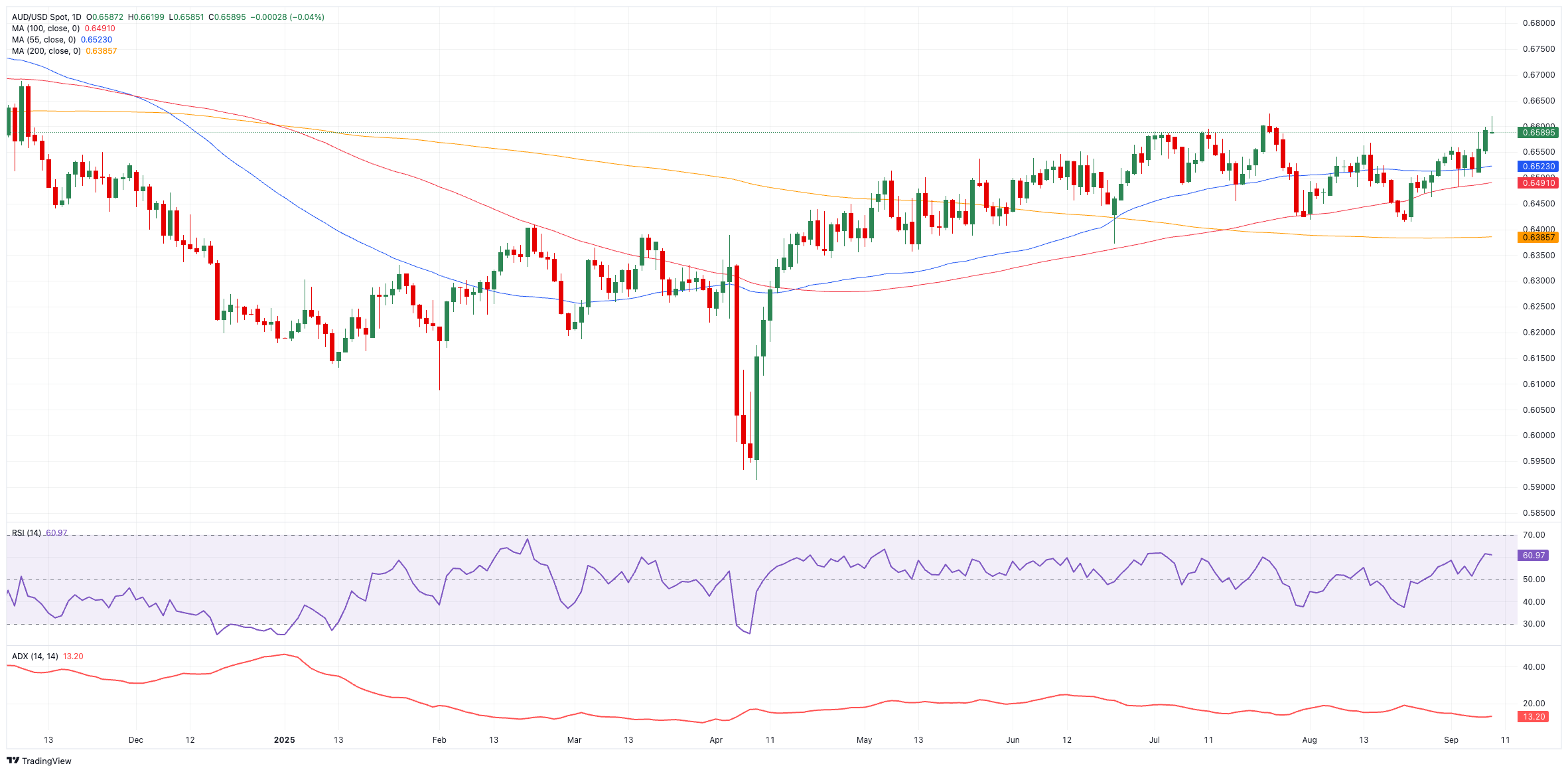- AUD/USD could not sustain the earlier move past the 0.6600 hurdle.
- The US Dollar regained appeal in response to the resurgence of the risk-off mood.
- Australian Consumer Confidence eased to 95.4 in September, Westpac said.
The Australian Dollar (AUD) gave back some ground on turnaround Tuesday, cutting short its two-day rebound. AUD/USD slipped back under pressure soon after touching seven-week highs north of 0.6600 the figure.
The pullback came as the US Dollar (USD) found its footing again. The US Dollar Index (DXY) bounced after its earlier slump to multi-week lows in the low-97.00s, while traders digested the Bureau of Labor Statistics’ (BLS) revision of Nonfarm Payrolls for the year to March and looked ahead to key US inflation data later this week.
Stubborn inflation keeps pressure on the RBA
Price pressures remain sticky in Australia. July’s Monthly Consumer Price Index (Weighted Mean) picked up to 2.8% from 1.9% in June, while Q2 CPI rose 0.7% QoQ and 2.1% on a yearly basis. That persistence explains why the Reserve Bank of Australia (RBA) is moving carefully on policy.
Australian economy shows surprising resilience
The broader economy is holding up well. August’s final Manufacturing PMI printed 53.0, while Services came in at 55.8, both safely in expansionary territory. Retail sales rose 1.2% in June, and the trade surplus widened to A$7.3 billion in July.
The labour market is also proving resilient. Unemployment edged down to 4.2% as payrolls grew by 24.5K. Private capital expenditure increased 0.2% in the April-June period, while GDP surprised to the upside with 0.6% quarterly growth and 1.8% YoY.
RBA sticks to a data-driven path
Earlier this month, the RBA trimmed rates by 25 basis points to 3.60% and lowered its 2025 growth forecasts. Governor Michele Bullock pushed back against calls for sharper easing, insisting policy will remain data-dependent.
Furthermore, Minutes from the last meeting showed faster cuts could come into play if the labour market weakens, but a slower pace is more likely if conditions hold up. For now, markets see the Official Cash Rate (OCR) staying unchanged on September 30, with roughly 30 basis points of easing priced in by year-end.
China’s recovery remains key for the Aussie
Australia’s outlook is still heavily tied to China. Q2 GDP rose 5.2% y/y, with industrial output up 7%, though retail sales lagged. August PMIs were mixed: manufacturing slipped to 49.4, while services improved to 50.3. The trade surplus widened, but deflationary pressures are expected to show up in this week’s August CPI data.
On monetary policy, the People’s Bank of China (PBoC) left its Loan Prime Rates (LPR) unchanged in August: The One-year stayed at 3.00% and the Five-Year at 3.50%, as markets had expected.
Traders cut back on AUD bearish bets
Positioning data shows traders are still leaning short on the Aussie, but less so. CFTC data revealed net speculative shorts dropped to five-week lows near 82.7K contracts in the week to September 2, while open interest fell to a three-week trough just above 185K contracts.
AUD/USD trapped in 0.6400–0.6600 range
For now, AUD/USD is trapped in a 0.6400–0.6600 range. Initial resistance sits at the September high of 0.6620 (September 9), closely followed by the 2025 ceiling at 0.6625 (July 24). A break above the latter would put the November 2024 peak at 0.6687 (November 7) back on the radar, before the psychological 0.7000 mark comes back into view.
On the other hand, first support emerges at the August base of 0.6414 (August 21), prior to the 200-day SMA at 0.6387 and the June low of 0.6372 (June 23).
Momentum signals are mixed: the Relative Strength Index (RSI) has climbed past 61, hinting at stronger buying pressure, but the Average Directional Index (ADX) around 13 suggests the broader trend is still lacking colour.
AUD/USD daily chart

What’s next for AUD/USD?
AUD/USD looks likely to stay sidelined in the short-term horizon at least. A stronger run of Chinese data, a shift in Federal Reserve (Fed) policy, or a surprise from the RBA would be needed to shake it out of its current range.
Australian Dollar FAQs
One of the most significant factors for the Australian Dollar (AUD) is the level of interest rates set by the Reserve Bank of Australia (RBA). Because Australia is a resource-rich country another key driver is the price of its biggest export, Iron Ore. The health of the Chinese economy, its largest trading partner, is a factor, as well as inflation in Australia, its growth rate and Trade Balance. Market sentiment – whether investors are taking on more risky assets (risk-on) or seeking safe-havens (risk-off) – is also a factor, with risk-on positive for AUD.
The Reserve Bank of Australia (RBA) influences the Australian Dollar (AUD) by setting the level of interest rates that Australian banks can lend to each other. This influences the level of interest rates in the economy as a whole. The main goal of the RBA is to maintain a stable inflation rate of 2-3% by adjusting interest rates up or down. Relatively high interest rates compared to other major central banks support the AUD, and the opposite for relatively low. The RBA can also use quantitative easing and tightening to influence credit conditions, with the former AUD-negative and the latter AUD-positive.
China is Australia’s largest trading partner so the health of the Chinese economy is a major influence on the value of the Australian Dollar (AUD). When the Chinese economy is doing well it purchases more raw materials, goods and services from Australia, lifting demand for the AUD, and pushing up its value. The opposite is the case when the Chinese economy is not growing as fast as expected. Positive or negative surprises in Chinese growth data, therefore, often have a direct impact on the Australian Dollar and its pairs.
Iron Ore is Australia’s largest export, accounting for $118 billion a year according to data from 2021, with China as its primary destination. The price of Iron Ore, therefore, can be a driver of the Australian Dollar. Generally, if the price of Iron Ore rises, AUD also goes up, as aggregate demand for the currency increases. The opposite is the case if the price of Iron Ore falls. Higher Iron Ore prices also tend to result in a greater likelihood of a positive Trade Balance for Australia, which is also positive of the AUD.
The Trade Balance, which is the difference between what a country earns from its exports versus what it pays for its imports, is another factor that can influence the value of the Australian Dollar. If Australia produces highly sought after exports, then its currency will gain in value purely from the surplus demand created from foreign buyers seeking to purchase its exports versus what it spends to purchase imports. Therefore, a positive net Trade Balance strengthens the AUD, with the opposite effect if the Trade Balance is negative.







